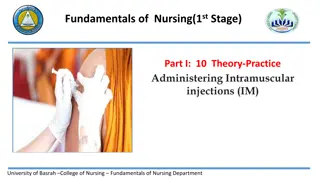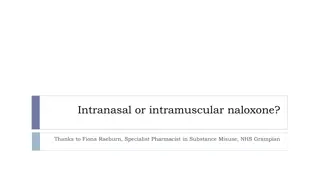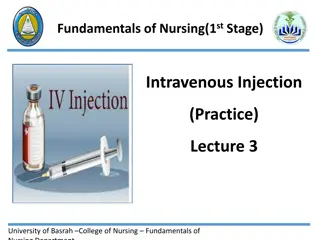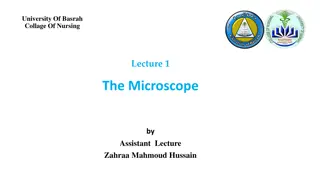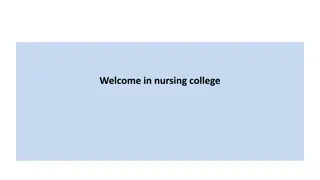Fundamentals of Nursing: Administering Intramuscular Injections - University of Basrah
Administering intramuscular injections is a critical nursing skill taught at the University of Basrah College of Nursing. This procedure involves delivering medications deep into the muscle tissue for optimal absorption and effectiveness. Different injection sites and techniques are emphasized to ensure safe and efficient administration of drugs and vaccines.
Download Presentation

Please find below an Image/Link to download the presentation.
The content on the website is provided AS IS for your information and personal use only. It may not be sold, licensed, or shared on other websites without obtaining consent from the author. Download presentation by click this link. If you encounter any issues during the download, it is possible that the publisher has removed the file from their server.
E N D
Presentation Transcript
Fundamentals of Nursing(1st Stage) Administering Intramuscular injections (practice) Lecture 2 University of Basrah College of Nursing Fundamentals of Nursing Department
Introduction Introduction An intramuscular (I.M) injection is a procedure used to insert medications into the muscle tissue. Some medications cannot be taken by the mouth because digestive juices can alter their effects. Other medications can be very irritating when they go into fatty tissues or veins. IM injections insert medications deep in the muscle, where there is an adequate supply of blood. This facilitates fast absorption, which can lead to better effects and outcomes. University of Basrah College of Nursing Fundamentals of Nursing Department 2
The speed of absorption is faster for intramuscular injection compared to subcutaneous injection. This is because the muscle tissue has a greater blood supply than the area just under the skin. Intramuscular injections should be administered so that the needle is perpendicular to the client s body and as close to a 90 degree angle as possible. University of Basrah College of Nursing Fundamentals of Nursing Department 3
Intramuscular Injections Used For Intramuscular injections are used to deliver drugs and vaccines. They are a common practice in modern medicine. Intramuscular injections are used when other types of delivery methods are not recommended. These include oral (swallowed into the stomach), intravenous(injected into the vein), and subcutaneous (injected just under the layer of skin). University of Basrah College of Nursing Fundamentals of Nursing Department 4
Sites of intramuscular injection * Vastus lateralis muscle. * Gluteus medius muscle. * Deltoid muscle. * Ventrogluteal muscle. University of Basrah College of Nursing Fundamentals of Nursing Department 5
Vastus Vastus lateralis lateralis muscle muscle The muscle is thick and well developed. Used in adult and is preferred site for administration of biologicals (immunizations) to infant. The middle third of the muscle is the suggested site for injection. University of Basrah College of Nursing Fundamentals of Nursing Department 6
Deltoid muscle Deltoid muscle Use this site only for small medication volumes (0.5 to 1 ml) ,and for administration of routine immunization, and when other sites are inaccessible because of dressing. The injection site is in the center of the triangle, about 3to 5 cm below the acromion process. This site has a potential for injury because the axillary nerve lies beneath the deltoid. University of Basrah College of Nursing Fundamentals of Nursing Department 7
Ventrogluteal Ventrogluteal muscle muscle The ventrogluteal muscle involves the gluteus medius and minimus. It is situated deep and away from major nerves and blood vessels and is a safe for all clients. Is a preferred injection site for infants, especially for administration of irritating or oily solutions, children, and adults. The index finger, the middle finger, and the iliac crest form V-shaped triangle ,and the injection site is the center of the triangle. University of Basrah College of Nursing Fundamentals of Nursing Department 8
Gluteus Gluteus medius medius muscle muscle University of Basrah College of Nursing Fundamentals of Nursing Department 9
Complications of Intramuscular Injection 1. Abscess. 2. Hematoma. 3. Injury to blood vessels. 4. Pain at the injection site. 5. Tingling or numbness. 6. Infection. 7. Bleeding. 8. Allergic reaction. University of Basrah College of Nursing Fundamentals of Nursing Department 10
Z track method The Z-track method is recommended for I.M injections. The Z-track technique, pulling the skin either downward or laterally before injection, reduces leakage of medication into subcutaneous tissue and minimizes pain. The nurse selects an I.M site, the overlying skin and subcutaneous tissues are pulled approximately 2.5-3.5 cm down or laterally to the side with the ulnar side of non- dominant hand. The skin is held in this position until the injection has been administered. University of Basrah College of Nursing Fundamentals of Nursing Department 11
Once the medication is injected, the needle remains inserted for 10 seconds to allow the medication to disperse evenly. The nurse then releases the skin after withdrawing the needle, which leaves a zigzag path that seals the needle track wherever tissue planes slide across each other. University of Basrah College of Nursing Fundamentals of Nursing Department 12
Equipment 1. Syringe with needle 2. Alcohol swab 3. Gauze pad 4. Medication vial or ampule 5. Disposable gloves 6. Medication administration record University of Basrah College of Nursing Fundamentals of Nursing Department 13
Nursing Diagnoses Nursing Diagnoses 1. Acute pain 2. Anxiety 3. Deficient knowledge regarding medication administration or drug therapy 4. Fear University of Basrah College of Nursing Fundamentals of Nursing Department 14
Implementation Implementation 1. Prepare medications for one patient at a time using aseptic technique. 2. Close room curtain or door. 3. Identify patient using two identifiers (i.e., name and birthday or name and account number) according to agency policy. 4. At patient s bedside again compare MAR or computer printout with names of medications on medication labels and patient name. Ask patient if he or she has allergies. 5. Discuss purpose of each medication, action, and possible adverse effects. 6. Perform hand hygiene and apply clean gloves. University of Basrah College of Nursing Fundamentals of Nursing Department 15
7. Select appropriate site. Note integrity and size of muscle. Palpate for tenderness or hardness. Avoid these areas. 8. Help patient to comfortable position. Position patient depending on chosen site (e.g., sit, lie flat, on side, or prone). 9. Clean site with antiseptic swab. Apply swab at center of site and rotate outward in circular direction for about 5cm (2 inches). 10. Hold swab or gauze between third and fourth fingers of nondominant hand. 11. Remove needle cap or sheath by pulling it straight off. 12. Hold syringe between thumb and forefinger of dominant hand; hold as dart, palm down. University of Basrah College of Nursing Fundamentals of Nursing Department 16
12. Administer injection. a) A Position ulnar side of nondominant hand just below site and pull skin laterally approximately 2.5 to 3.5 cm (1 to 11 inches). Hold position until medication is injected. With dominant hand inject needle quickly at 90-degree angle into muscle. b) If patient s muscle mass is small, grasp body of muscle between thumb and forefingers. c) After needle pierces skin, still pulling on skin with nondominant hand, grasp lower end of syringe barrel with fingers of nondominant hand to stabilize it. Move dominant hand to end of plunger. Avoid moving syringe. d) Pull back on plunger 5 to 10 seconds. If no blood appears, inject medication slowly at rate of 10 sec/mL. e) Wait 10 seconds, smoothly and steadily withdraw needle, release skin, and apply gauze gently over site. University of Basrah College of Nursing Fundamentals of Nursing Department 17
13. Apply gentle pressure to site. Do not massage site. Apply bandage if needed. 14. Discard uncapped needle or needle enclosed in safety shield and attached syringe into puncture- and leak-proof receptacle. 15. Remove gloves and perform hand hygiene. University of Basrah College of Nursing Fundamentals of Nursing Department 18
University of Basrah College of Nursing Fundamentals of Nursing Department 19


